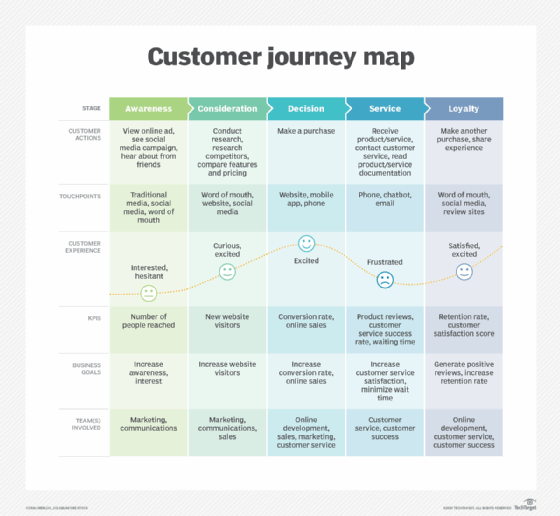
Oleg Blokhin - Getty Images
How to create an omnichannel marketing strategy
Marketers often struggle with the complexities of omnichannel implementation. To get started, they can set their business goals and invest in the right technologies.
Modern consumers often expect seamless interactions with brands across platforms.
Unlike traditional multichannel strategies that operate in silos, an omnichannel approach integrates multiple channels, like social media, in-store and mobile apps, to deliver a cohesive customer journey. This approach offers customers consistent messaging and UX across channels, yet requires heavy planning, investment in data integration tools and frequent updates.
The result of omnichannel marketing is a unified brand experience that increases engagement, improves customer satisfaction and drives sales.
What is omnichannel marketing?
Omnichannel marketing synchronizes all marketing channels to create a smooth, unified CX. Unlike siloed marketing strategies -- meaning separate strategies for in-store, online and social media -- omnichannel integrates the digital touchpoints customers use every day. The goal is to offer a consistent, personalized and seamless experience across channels and devices.
Key characteristics of an omnichannel marketing strategy include the following:
- Consistency. Unified brand messaging, tone and visual identity across all channels offer a recognizable and familiar experience for customers, regardless of how or where they engage with the brand.
- Personalization. Marketers use customer data to tailor messaging based on individuals' preferences, behaviors and past interactions with the brand.
- Integration. Organizations integrate and share data between all customer touchpoints, like websites, social media, mobile apps, in-store and customer service channels. This lets customers transition seamlessly between channels, yet requires sophisticated data management platforms to track customer interactions.
- Customer-centric. Omnichannel marketing prioritizes customers' needs, preferences and convenience as it meets them on their preferred channels.
- Data-driven insights. An omnichannel approach relies heavily on data analytics to gain insights into customer behavior across channels. Marketers use this data to improve their decision-making and refine their strategies.
- Flexibility and adaptability. As customer behaviors and technology evolve, so must omnichannel strategies. Brands must continuously adapt to meet changing customer expectations and take advantage of new opportunities.
7 tips to create an omnichannel marketing strategy
Omnichannel marketing can improve CX, but it requires organizations to identify clear business goals and invest in sophisticated data collection and integration tools.
1. Identify business goals
Successful marketing strategies begin with clear, actionable business goals. These goals offer direction to focus omnichannel efforts on specific outcomes, like enhanced customer loyalty, increased sales and improved brand awareness.
For example, marketing leaders can create SMART goals that align with their overall business objectives. These could include increasing online sales by 20% within the next quarter or boosting customer retention rates by 15% through improved service interactions.
2. Collect customer data from various sources
Marketers can collect data across all customer interaction points to gain a holistic view of the customer journey. This data lets them personalize campaigns, enhance CX and increase the effectiveness of their omnichannel strategies.
Yet, this doesn't mean brands should ask customers to fill out long forms at every step. Instead, they can consciously collect data along the buyer journey where it genuinely brings value to customers. For instance, an online retailer might ask customers for their email addresses or phone numbers during checkout to let them track their orders.
To collect data across the customer journey, marketing teams can implement CRM systems and data management platforms. These systems can capture, aggregate and analyze data from different sources, including online purchases, social media interactions, and in-store visits.
3. Understand the audience
A deep understanding of the target audience's behaviors, preferences and pain points can help marketers create an omnichannel approach. This knowledge helps them craft personalized communications and offers, which are more likely to resonate and drive customer engagement.
Marketing leaders can also use data to develop detailed customer personas. Insights from surveys, social media analytics and purchase history data can help them tailor their strategies to the needs and preferences of various audience segments.
4. Update the customer journey
Marketers can continually refine the customer journey to reflect new insights and changes in consumer behavior. Regular updates ensure marketing strategies remain relevant and guide customers smoothly from awareness to purchase.
Marketing teams should continuously analyze customer feedback and interaction data to identify opportunities for improvement. This could involve adding new touchpoints, eliminating pain points or enhancing existing channels for improved performance.

5. Integrate different channels
The integration of various digital and physical channels ensures each interaction builds upon the last, regardless of which platform customers use. For instance, an online retailer might send customers an email or text message to remind them of any unpurchased items in their online shopping carts. Additionally, marketers can also use these interactions as an opportunity to reinforce brand identity.
To integrate these different channels, organizations can invest in omnichannel marketing platforms. These systems can help synchronize data and workflows across all channels and devices.
6. Invest in technology
The strategic use of technology can support and enhance omnichannel strategies, because the right software can automate workflows, personalize interactions at scale and offer actionable insights.
To implement the right tools, marketing leaders should assess their company's existing technology systems for gaps or redundancies. Common tools in an omnichannel technology stack include CRM systems, marketing automation platforms and analytics tools designed for omnichannel use. These technologies can work together to manage customer data, personalize marketing efforts and measure campaign performance across channels.
7. Optimize and test
Marketing teams can iteratively test and refine their omnichannel strategies based on data-driven insights to understand which actions and processes to double down on and which to alter or abandon. This ongoing optimization ensures marketers adapt their omnichannel strategies to changing customer expectations and market conditions.
Marketing leaders can regularly use A/B testing across different channels to identify which techniques and campaigns work best. Analytics tools can help them measure performance against business goals and refine the strategy accordingly.
Key takeaways
Modern marketers can't view an omnichannel marketing strategy as an optional approach, but rather as one essential for growth and success. By following these best practices, marketing teams can meet customers on their preferred channels in a consistent, personalized and engaging way. The result is a seamless customer journey that increases customer satisfaction, builds loyalty and increases profits.
The goal of omnichannel marketing is to create a cohesive, integrated experience that resonates with audiences at every touchpoint. With careful planning, execution and regular updates, marketers can implement effective omnichannel strategies and gain a competitive edge in an increasingly complex digital landscape.
Griffin LaFleur is a MarketingOps and RevOps professional working for Swing Education. Throughout his career, Griffin has also worked at agencies and independently as a B2B sales and marketing consultant.







